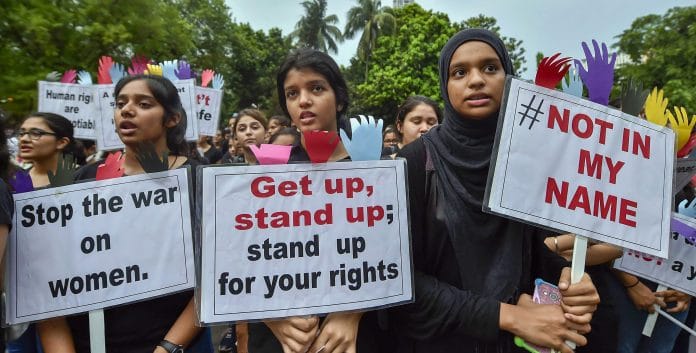Finance Minister Nirmala Sitharaman, Shaheen Bagh protesters, and Elizabeth Warren have something in common. The world is unable to deal with their anger. Sitharaman and Warren are constantly told to be less angry and smile more. Shaheen Bagh women protesters are told to end their protests, go back and tend to their infants, by no less than the Supreme Court of India.
Rage is a fundamental part of a woman’s psyche, because unless we rave and shout, it is quite difficult to be heard in the void that this masculine, patriarchal world is. Thus, women are always angry.
Boxes, designed by men
“My Kali kills. My Draupadi strips. My Sita climbs on a stranger’s lap. All my women militate. They brave bombs, belittle kings, take on the sun, take after me.”
When poet Meena Kandasamy reoriented goddesses – seen as female ideals by Indians – as angry women with an agency of their own, she created quite a stir.
Pulitzer Prize winner Laura Ulrich puts it best: “Well-behaved women seldom make history”.
And this is precisely why society hates an angry woman – it is scared of them. They don’t fit into the neat boxes that men, very benevolently, have carved and labelled the ‘ideal’ woman, the ‘nice’ woman. This woman speaks softly, expresses her views in moderation.
But the women who kick aside the box, because enough is enough, are dealt with in the only way patriarchy knows how to — it calls them ‘demons’, ‘witches’, ‘sluts’. Even men who claim to support women are turned off by ‘those women’. Women who are brash, argumentative, vocal, aggressive.
But female rage is so much more than these regressive labels; it’s a form of self-expression and, more importantly, a reclamation. It seeks to reclaim the exhaustion, the pain, the labour that comes from interacting with this fundamentally unequal world. It’s a pain that all those who identify as women — white, black, Asian, queer, Muslim, Dalit — have felt and continue to feel.
Also read: Indian IT industry attracts more women, but many exit within first 5 years in the job
Anger is not a good look on women
A group of Muslim women decided to sit in protest against India’s divisive new citizenship law and the proposed National Register of Citizens that threatens their home and the homes of their children. Two months later, the eulogised, mythic persona of Narendra Modi and Amit Shah, which is particularly hinged on a violent expression of masculinity, proved unable to shake the resolve of the protesters at Shaheen Bagh. The women, young and old, continue, inspiring as ever.
But wait, there is a caveat. For those in the ‘mainstream’, including self-proclaimed supporters, these women are amazing as long as they are peaceful and ‘within limits’. The moment they get angry, they lose their appeal.
When News Nation anchor Deepak Chaurasia and Zee News anchor Sudhir Chaudhury were not allowed to enter Shaheen Bagh, even though they have on several occasions levelled the worst sort of accusations at the protesters, it was the women who were blamed. The fact that they were part of a marginalised religion, one which is routinely demonised, made matters worse.
Miles away, when Democrat presidential candidate Elizabeth Warren called out Mike Bloomberg as a sexual harasser, many were left feeling uncomfortable. How could she be so outright in her accusations? The fact that she was angry, called Bloomberg “an arrogant, selfish billionaire” (which he is), made public his past record of sexually harassing multiple women, she broke the code men had written for her, did something that was not ‘nice’.
Someone even tweeted that “mean and angry” is not a good look on Warren.
Also read: Sabarimala temple, Gujarat college or PMS jokes: How Indians loathe menstruating women
‘She is beautiful when she is angry’
Not a good look is just a nice way of men saying that we hate it. The trope of the angry, vocal woman has been used in two distinct ways in literature and mythology.
She either becomes Medea, the witch who murders her own children as revenge for abandonment; or Bertha Mason, whose ‘madness’ requires her to be locked up in the attic.
Or she is Kannagi, the woman who tore her breast and flung it into the streets of Madurai, burning the city down. And then, very conveniently, to explain away her anger, she is revered as a goddess.
What’s common in both instances is that anger becomes the woman’s all-encompassing identity. Nothing beyond that. She is vile and ugly. Or she is a goddess in service of patriarchy.
What is left unrecognised is her beauty. ‘She is beautiful, when she is angry’ — the apt title of a 2014 documentary on the American suffragette movement. And she is angry because she has the right to be, centuries of abuse is at the core of this anger, so is it really a surprise when women proclaim ‘F**k patriarchy’?
A woman’s anger is the beginning of movements, revolts and revolutions. It is the beginning of history. A female history.






